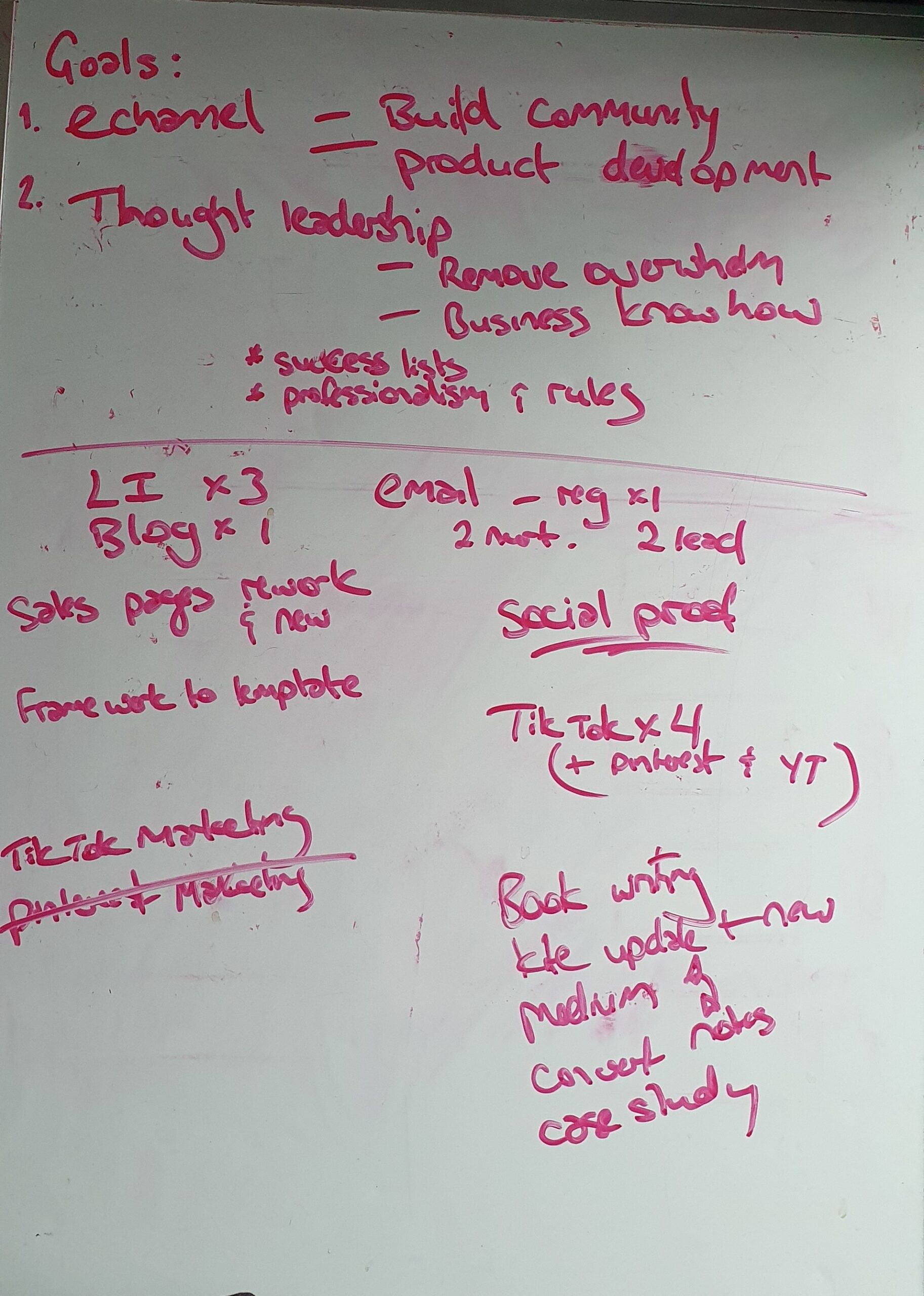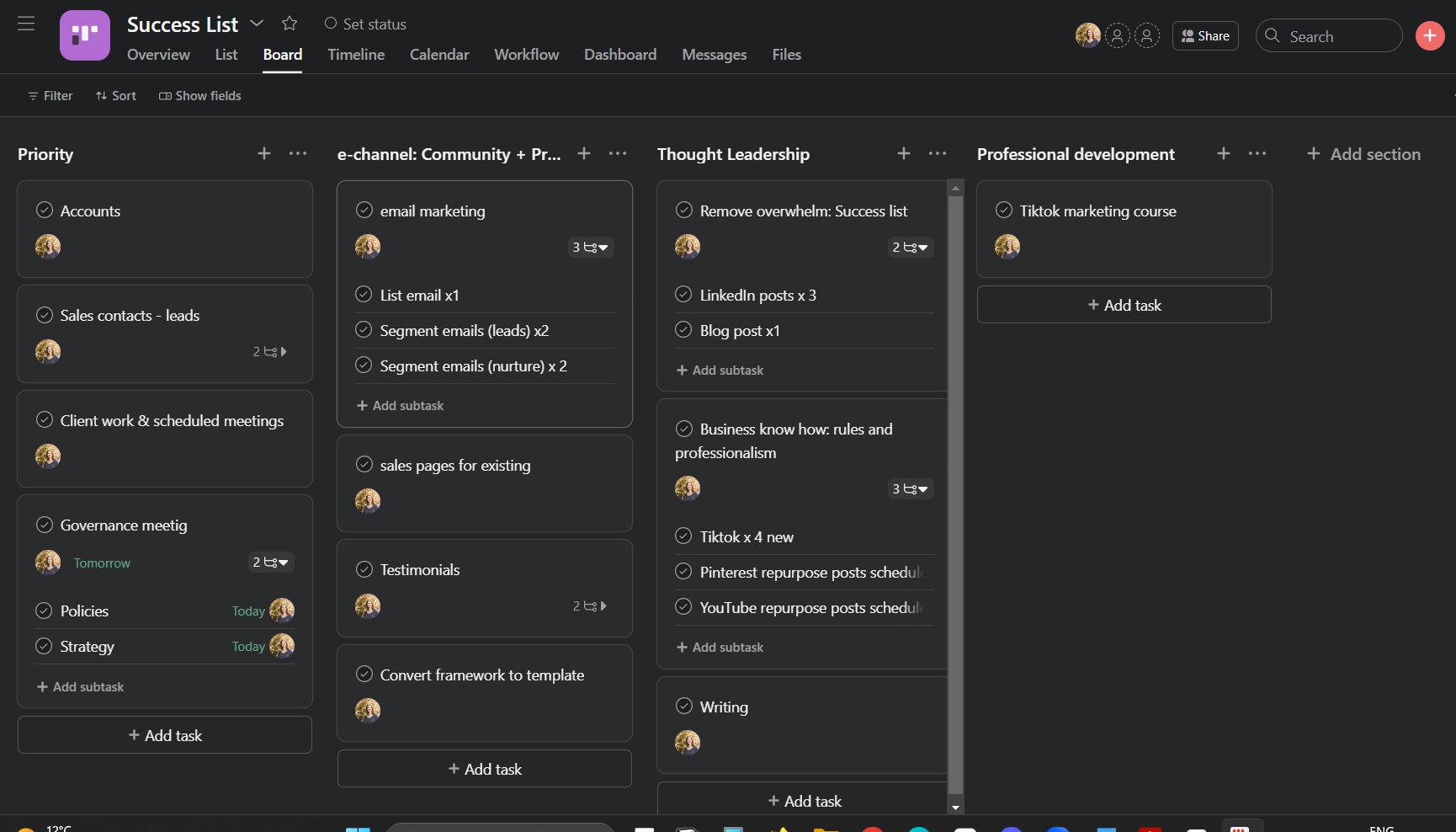How do you ensure your Task list actually gets you to success?
Success is subjective.
In the same vein that every persons values differ, a single measure of success doesn't exist.
So why do we insist on making the sum of our days achievements boil down to how many tasks we tick off a list?
Or even whether we tick them off at all?
For a long time I thrived on stress, or I thought I did.
The busier I was, the happier I thought my life was. Until I wasn't.

And it took a really long time for me to unpack that the issue was this thinking I had that I was more valuable, the more I did.
Aka, how many tasks I could take on for others, and tick off my list.
Unfortunately, I maxed out my capacity before I realised that this wasn't true. In simple terms, I entered burn out.
The hard part of this lesson to swallow; it wasn't my first time.
And I completely missed the symptoms. Again.
This time I realised early enough to not go down in a screaming heap like the first experience, but it did take me longer to recover.
Apparently it gets harder each time.
That's not a truth I intend on proving.
But I'm getting distracted.

To get myself back on track from burnout, I started mapping out my business planning and creating my to-do lists.
Planning is my happy place, I love having the clarity of what I want to achieve and knowing exactly how I'm going to do that.
But this time was different.
I had the simplest plan and a really clear direction, with a step by step process to get there.
And I couldn't do it.
The more I tried, the more I froze.
Instead I threw myself into everything else that took my attention and looked feasibly as if it might apply to my goals.
There were a lot of rabbit holes. Some of them had great potential, but whenever I tried to follow through I couldn't move on them.
And then I realised that I was quite literally refusing to do what I HAD to do.
I saw a clear pattern of avoidance and distraction, and recognised it had everything to do with my lists of non-achievement.
If I didn't think about the steps, I could move on it. But as soon as a task was added to my to-do list, it stagnated.

The more I thought about this, the more I realised it was happening everywhere in my life.
Making dinner. On it.
Until one of my kids told me they were hungry and wanted it NOW. Or I thought about it as "having" to do it.
At that point my bare minimum bitch entered the room and I would make some excuse for why I couldn't cook the meal I had planned, and instead order takeaways or resort to cheese toasties.
Gardening, one thing I love to do, keen as a bean to get out there. Until my husband pointed out what needed doing.
All of a sudden, I wasn't interested.
Knowing this and changing it though were different things.
Gahhh!! Why couldn't I just say what I wanted to achieve and then make that happen?
Oh! Why couldn't I do that?
Could I do that?!?
So in typical Sel style, I went down another rabbit hole, found a possible solution and started making it my own.
Enter, the success list.
Essentially it's a removal of detail.
The justification is that too much information overwhelms the senses.
The real strength in a success list though, isn't in how little detail you include.
It's in defining your own measure of success.
It's in looking at what time you have realistically to get your work done within, and deciding what you can feasibly achieve within that period - including time for necessities of life.
The success list isn't a place to note down all the little details you need to remember in your day.
It's a list that you can look at, where you have defined what your own measure of success is and what progress you will make towards that.
Quality over quantity.
On your terms.
The problem with planning out our time
We're so used to "busy" being the measure of success, that we've gotten used to filling up our planners with endless tasks and time blocking.
Why do we need to fill our planners with every single step in a process?
Going back to basics, there is a theory that 80% of what we achieve is from only 20% of our effort.
Why wouldn't we apply that rule and just put the end outcome as the task to complete?
And why wouldn't we take it a step further and reframe it as the success we will achieve?
Most businesses have standard operating processes (SOPs) and if they don't, they should have.
Why would you list all of the individual tasks to do in your planner, instead of just linking the SOP?
Go back to the 80/20 rule, creating your success list is about cutting out noise.
The only rule is that you are in charge of your own success and what that looks like.
The Success list In a nutshell
This is a reframing of things from "all the stuff I need to do", to "I will have succeeded when I have achieved XX".
Instead of creating a tick list of all the things to do, you're creating a high-level overview of the end measure of success.
You can still have a list of things to do so you know what parts of the puzzle are still to be added, but they're not part of your success list itself.
The goal is to remove the overwhelm by:
a) taking the list of all the individual things out of your main line of sight, and;
b) only including things that immediately contribute to your goals.
Now, you're more than likely to have a case of shiny object syndrome at some time. That's ok. If you're that person, create a separate list of those for when you've got spare time to fill. But the rule of success is that you don't touch them until you've achieved what you specified you wanted to.
If it doesn't contribute towards the goal you've specified, it's a no-go zone until you've achieved the measure of success.
The guidelines for creating your success list are as follows:
- You need to know what your business goals are. What is it that you're working towards?
- Your measure of success needs to contribute towards achieving these goals.
- You choose the period of time for your list. I operate on a weekly plan because I spread my tasks across it and it allows for life interruptions (eg illness and kids). Some people work better when they define what tasks are happening on what day, my sole measure is the end of week achievements.
Thinking about those guidelines, it's time to create your success list.
- Specify the tasks that actually must be done. These go into a category of their own - I label mine priority focus. This category is the top level and I start my week on this list.
I don't move on to anything else until these are complete.- Now, I also include client output within here and meetings don't all happen at the start of the week. So, anything that is time specific goes into my calendar as a time block (which in turn triggers a reminder).
- The structure of my week is that Monday and Tuesday are dedicated to working on my business and the rest of the week has client work on it - you will find your own way of managing time to suit this category.
- Specify your measure of success for this period. I call those the focus goals and, for me they contribute towards my strategic planning outcomes.
Create a category for each goal. As a general rule, I only have 2-3 categories within a week. - Identify any tasks (not the step-by-step, the outcomes or deliverables) that will contribute towards achieving those goals.
- If there are extra tasks or outcomes you want to achieve, but they don't fit the categories outlined, they go into another category.
These don't get touched unless you have finished everything else that you've specified as a measure of success - aka, they're the lowest priority and are really just a distraction. The reason we put those on a list is to get them out of your head and stop distracting you.
Making this work in practice: aka, how I structure my success list.
I use a combo approach. I manage my success list using project management software (Asana) and I map out my thinking using a whiteboard.
Each week I review the week that was and then map out the next one on my whiteboard.
Then I update Asana with whatever changes need to occur.
I manage my list by segmenting into their categories aligned to the focus goal, in a project template I've created in Asana
This works for me because I can link files and web pages, utilise SOP documents and can assign tasks easily to my support workers (VA/other contract support). It also enables me to link specific time deliverables to my calendar.
Mapping out this weeks success...

...And converting it into my project management software.

I've seen people refer to a success list as breaking tasks into must-do, should-do and could-do (and excluding with shouldn't-do) so they can prioritise.
Because of the way my brain works, that's not a method I was keen to pursue. My mental block is around the perception of demand. I needed to reframe my "to-do" into a perspective of success and then reduce task demand by only focusing on that measure of success vs all of the steps it would take to get there.
Here's my caveat if you're neurodivergent; it is likely that you get a dopamine hit from making a list (yea, I see you) and ticking things off. So much so, you might add things you've already done to the list just so you can tick them off (I told you I see you).
This isn't one of those lists.
By making a high level list of what success looks like to you at the end of the week, and only adding tasks of things that MUST be done, you are able to respond to life needs and meet your own self head on.

